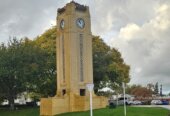
The quarry on Oreipunga Rd does not have resource consent.
Waikato’s environmental watch dog has visited the site of an illegal Waipā sand quarry – 28 days after it was alerted to its existence.
Waikato Regional Council says there were no “apparent risks” to the environment on the day of its inspection and members of the incident response team took the opportunity to provide advice on the installation of erosion and sediment controls while they were there.
The Oreipunga Road quarry in Maungatautari operated without a resource consent for at least five years by Beacon Hill Contracting. All operations at the quarry were suspended on April 13 by Waipā District Council.
One of the four shareholders in the company is Elwyn Andree-Wiltens who resigned as a Waipā district councillor on April 25 because of her involvement in the quarry and “perceived” conflict of interest.
In a response to The News on why it took the regional council so long to visit the site, compliance manager Patrick Lynch said the council receives more than 2200 complaints a year regarding the environment.
Pressed on how many related to illegal sand quarries close to the Waikato River, Lynch said the calls were “many and varied.”
And in another confusing development, Waipā District Council says it received a resource consent application for the quarry on Monday after it was submitted two days earlier by consultants acting for Beacon Hill – yet Andree-Wiltens told The News it was submitted on April 20.
Mitchell Daysh, a Hamilton-based specialist consultancy, said it provided the district council with a draft consent application to show Beacon Hill made “meaningful attempts” to address the non-compliance.
Rhys Powell, who originally tipped off the regional council to the quarry’s non-compliance on April 1, said if neither the regional nor district council decide to take any subsequent legal action against the quarry, he would.
He told Waipā chief executive Garry Dyet in a Code of Conduct complaint against Andree-Wiltens on April 23 he was prepared to take a private prosecution for breaches of the Resource Management Act (RMA) if the council did not act.
Lynch confirmed anyone could do that, including the regional council, if it deemed there were any serious breaches of the RMA.
“While we are still completing our enquiries, a breach of the aspects of the RMA administered by the regional council has not been identified.”
No rivers were impacted at the time of the inspection or would have been when the quarry was operating, he said.
The regional council was now establishing whether the activity met Permitted Activity rules under the Waikato Regional Plan.
Yet Mitchell Daysh consultants, who lodged the resource consent application with the district council, also filed an earthworks consent application with the regional council just before close of business last Friday.
The incident response team told Beacon Hill the regional council would complete assessments to check whether any other consents were needed.
“The landowners submitted a consent application on Friday prior to any further feedback from ourselves,” said Lynch.
Meanwhile Waipā District Growth and Regulatory services group manager Wayne Allan, who was unavailable to talk to The News but provided a statement via email, said the council had not used any sand from the quarry for council-related projects.
And Service Delivery general manager Dawn Inglis said the council was not aware of any contractors using sand from the quarry on any council projects.
“Contractors are required to demonstrate that their products are of the required quality and meet all of our standards, however they are not required to provide source information for materials used,” she said.
See also Legal twist in council sacking








